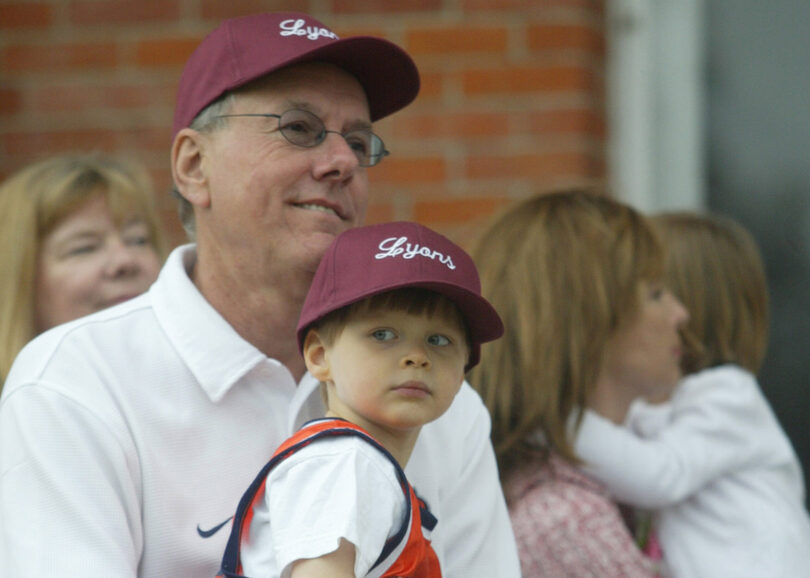LYONS LEGEND: Jim Boeheim’s hometown of Lyons, New York, celebrated with him in 2003

Courtesy of Finger Lakes Times
im Boeheim is proud to be from Lyons, New York. In 2003, his hometown honored his title win with "Jim Boeheim Day."
L
YONS, N.Y. — A nightmarish layer of sub-freezing air emerged above upstate New York on a Thursday in 2003. By Friday morning, half an inch of ice had accumulated throughout the region. Freezing rain morphed into snow and sleet. By Saturday night, trees and powerlines littered the ground. A travel warning was put in place. Airports closed.
At the storm’s peak, the Rochester Gas and Electric Corporation estimated 211,000 people were without power. Among those were roughly 3,600 residents in Lyons, New York, who had a basketball game to watch on April 7.
The town’s wunderkind, Jim Boeheim, was coaching in the national championship.
A few residents in Lyons still had power. The rest dispersed to find a working television. Some went to a Niagara Falls casino. Others went to a hotel in nearby Geneva. Tony Patanzo ventured to his in-laws’ house in Clyde, the town over. Jim Blandino went to his cousin’s place just outside of Lyons.
Somehow, all of Lyons managed to watch Boeheim win his only title. Blandino returned home after the game, still without power. He pointed to the air and yelled a message directed to Boeheim’s late father, James Boeheim Sr. “Hey Bobo, we finally got one!” The lights flickered.
“Someday, his father said he would win,” Blandino said.
That ensuing summer, the town held “Jim Boeheim Day” in the coach’s honor. He’d moved 50 miles east to Syracuse after graduating high school, but never forgot his hometown as his career progressed. He came back for reunions with his old team, and spoke at graduations and Lyons Hall of Fame ceremonies. He helped finance the rebuilding of the town’s library.
Boeheim is proud to be from Lyons. The town, where his persona was synonymous with the sound of a bouncing basketball, would go on to shape the foundation of his playing and coaching career.
“A lot of dedicated people live here in whatever their professions might be. Jim could be characterized by that,” said Patanzo, who’s four years younger than Boeheim. “Whatever he did, he was dedicated to it and put forth a great deal of effort.”

After Syracuse won the 2003 national championship, Jim Boeheim’s hometown of Lyons, New York, held an event in his honor. Courtesy of Spencer Tulis | Finger Lakes Times
Established in 1811, Lyons started as the “peppermint capital of the world” when H.G. Hotchkiss moved his Hotchkiss Essential Oil Company in 1841. Hotchkiss needed cooks and plastered a poster about the jobs downtown to spread the news. Boeheim’s relatives took the job, according to Patricia Alena, who works at the Peppermint Museum.
In 1854, Boeheim’s great-grandfather opened the Boeheim Funeral Home on William Street. Boeheim grew up at the house, which is still there today.
Boeheim slept and ate basketball, Alena said. He practiced at one of three baskets behind Lyons Elementary School almost every day. Alena lived across the street and had a big picture window in her living room. Her dad would inform her every time Boeheim walked by.
“He’d go, ‘oh, there goes Jimmy again,’” Alena said.
When Boeheim was around 10, he went to the court with a brand new basketball. He was playing alone when Blandino, who’s six years older than Boeheim, approached him. Blandino handed his ball over to Boeheim and asked if he could use his ball for one game. Boeheim shook his head “no,” pressing the ball tightly against his chest with both hands. He told Blandino he could only use the ball if he could join.
Boeheim guarded Blandino like an “octopus.” Every time Blandino turned around he was face-to-face with Boeheim’s green softball cap and glasses, his hands rotating like a windmill. With the rules they were playing with, Boeheim was supposed to give Blandino space to bring the ball in. He wouldn’t do it.
“Every place I went, Jimmy was there,” Blandino said. “He was tenacious, he really wanted to win.”

Established in 1811, Lyons started as the “peppermint capital of the world” when H.G. Hotchkiss moved his Hotchkiss Essential Oil Company in 1841. Courtesy of Spencer Tulis | Finger Lakes Times
When Boeheim wasn’t playing on his own, he watched Lyons High School’s team. He was always the first to the gym before each game, his nose pressed against the doors as he waited for them to open. Boeheim always had a big smile and a quarter in his hand, ready to get his ticket, Blandino said.
Boeheim always sat on the left side of the floor, testing out three chairs before settling in the corner. He shot around with the players before the junior varsity game at 7 p.m. After the games, he was the first to greet the varsity team when they left the locker room.
Years later, Boeheim would be in the locker room himself. By that time, there was a hoop in the backyard of the funeral home. Boeheim Sr. had added lights so Boeheim could play when it got dark.
While the rest of his teammates practiced for football over the summer, the younger kids in his neighborhood joined Boeheim in his backyard. He started coaching them in recreational leagues.
“He was coaching while he was in high school, quite frankly,” Patanzo said. “He was a very good coach.”
Patanzo said Boeheim’s knowledge of the game stuck out when he coached. Kids also emulated his work ethic, which made him an elite force on the basketball court despite his lanky physical stature. John Hewes, who played golf with Boeheim, remembered Boeheim Sr. telling him that Boeheim put in so much effort that he wore out a brand new pair of shoes at a basketball camp.
“He’d come home with holes in (his sneakers),” Boeheim Sr. said to Hewes.
Boeheim’s knowledge about the game was cultivated by then-Lyons’ head coach Dick Blackwell, who taught Boeheim the 2-3 zone, though it was called a sliding zone or matchup zone at that time. Under Blackwell, Lyons’ 1962 team reached the sectional finals against East Rochester. Boeheim fell on the floor after sinking a shot to send the game to double overtime, though Lyons would go on to lose. Blandino said the loss probably haunts Boeheim to this day.

In 1854, Boeheim’s great-grandfather opened the Boeheim Funeral Home on William Street. Jim Boeheim’s dad built a court, with a light, behind the house. Meghan Hendricks | Photo Editor
Boeheim enrolled at Syracuse that year, beginning a 60-year relationship with the university. He would return to play golf with Patanzo during the offseason at Wayne Hills Country Club every weekend. Patanzo joked his temperament was worse on the golf course than the basketball court.
Despite Boeheim’s absence, the town’s residents kept up with him. They drove to Syracuse or watched SU play from home. They saw his early success coaching in the Big East, the heartbreak of the 1987 national championship game. Finally, in 2003, they did whatever they could to see him reach the top.
“That weekend was kind of tough weather wise but it was a tremendous experience for Jim and Syracuse,” Hewes said.
Ackie Zacharilla, who was Boeheim’s godmother, started conversations about how they could celebrate Boeheim. She formed a committee with Alena, Patanzo and others to plan a “Jim Boeheim Day.” They set up a stage at the Wayne County Courthouse. They set up chairs for players and cheerleaders from the 1962 team. They plastered a banner with Boeheim’s name on William Street.
Boeheim arrived at the event in the back of a fire engine, a maroon “Lyons” hat on his head, just hundreds of feet from his childhood home. He got out of the red truck, walked past his high school teammates and onto the stage.
“He saw all sorts of people that knew him, neighbors, friends. He was smiling through the whole thing,” Alena said. “It was a holiday in Lyons.”
Photograph courtesy of Spencer Tulis | Finger Lakes Times




